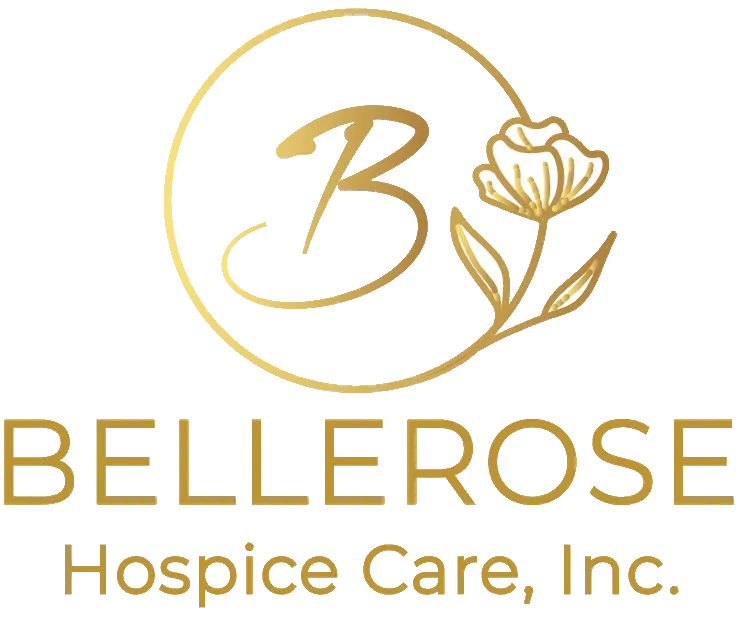Follow Us:
Fax: 661-360-8880
Our Mission
Our Mission is to affirm the cycle of living by enhancing quality for those at the end of life. The Vienna Hospice and Palliative Care standard is to compassionately care for patients, families, and to empower those we serve to have quality of options that afford them comfort, dignity, and support.




Resources for Healthcare Professionals



Hospice and Palliative Care Resources for Healthcare Professionals
At Bellerose Hospice, we’re committed to improving the quality of care you provide your patients, residents and members with advanced illness. As a national leader in hospice care for 40 years, Bellerose Hospice cares for complex patients and manages health care transitions.
Bellerose Hospice understands what it takes to care for patients and their families in the final stages of life. Our reputation is distinguished by our deep expertise in hospice and palliative care.
Timely and appropriate identification of hospice-eligible patients increases the likelihood that they and their families will benefit from compassionate, end-of-life care. By law, healthcare professionals must certify that patients meet guidelines to be eligible for a referral to a hospice provider.
Hospice Care Eligibility Criteria
To qualify for hospice care, a patient should meet the following guidelines:
1. Terminal Illness: The patient's prognosis should be ≤ 6 months, and they or their family should have chosen palliative care.
2. Declining Functional Status: The patient's functional status should be assessed using either:
a) Palliative Performance Scale (PPS) rating of ≤ 50%-60%, or
b) Dependence in 3 of 6 Activities of Daily Living (ADLs).
3. Nutritional Status: There should be an alteration in the patient's nutritional status, such as > 10% loss of body weight over the last 4-6 months.
4. Documented Clinical Deterioration: The patient should have observable and documented deterioration in overall clinical condition within the past 4-6 months, indicated by at least one of the following:
a) ≥ 3 hospitalizations or ED visits,
b) Decrease in tolerance to physical activity,
c) Decrease in cognitive ability, or
d) Other comorbid conditions.
Please note that these guidelines are provided as a helpful tool and should not replace a physician's professional judgment. They aid physicians in determining if their patients meet the clinical criteria for hospice eligibility in cases of life-limiting illnesses.
ALS Patient Eligibility for Hospice Care
Patients with amyotrophic lateral sclerosis (ALS), also known as Lou Gehrig's disease, may be considered eligible for hospice care if they meet the following criteria:
1. Rapid Progression of ALS and Critically Impaired Ventilatory Capacity, OR
2. Rapid Progression of ALS and Critical Nutritional Impairment with a Decision Against Artificial Feeding, OR
3. Rapid Progression of ALS and Life-Threatening Complications, including:
- Recurrent aspiration pneumonia
- Multiple, stage 3-4 decubitus ulcers, especially if infected
- Upper urinary tract infection (e.g., pyelonephritis)
- Sepsis
- Recurrent fever after receiving antibiotics
Bellerose Hospice offers these guidelines as a useful tool, but they should not replace a physician's professional judgment.
Clinical Eligibility for Hospice: End-Stage Amyotrophic Lateral Sclerosis (ALS)
In recent times, there has been a growing focus on palliative and end-of-life care, significantly impacting individuals with ALS and their families. Hospice support during the final stages of the disease provides patients with peace and effective symptom management, often allowing them to remain in the comfort of their homes.
Hospice services for ALS are specifically designed to complement the efforts of primary physicians, focusing on alleviating suffering, providing comfort, upholding dignity, and facilitating closure for both patients and their families.
Clinical Characteristics of Hospice-Eligible ALS
Determining the appropriate timing for end-of-life care can be challenging due to the clinical characteristics of ALS. A limited prognosis is often indicated by the "rapid progression" of the disease, defined as a significant neurological disability developing over a 12-month period.
ALS may be further complicated by secondary and co-morbid conditions. Secondary conditions, like dysphagia, pneumonia, and pressure ulcers, arise due to the impairment of respiratory functions, swallowing, muscle power, and muscle tone common in ALS. Co-morbid conditions frequently accompanying rapid ALS progression may include chronic obstructive pulmonary disease (COPD), pyelonephritis, upper urinary tract infections, septicemia, and recurrent fever after antibiotic treatment.
ALS Hospice Eligibility and Care Plan
Hospice Eligibility for ALS
Patients become eligible for hospice care when a physician clinically determines that their life expectancy is six months or less, considering the typical progression of the terminal disease. In end-stage ALS, two crucial factors play a significant role in determining the prognosis: the ability to breathe and the ability to swallow.
In ALS, the use of feeding tubes can be a standard aspect of treatment. G-tubes and ventilators can support extended life expectancy. However, hospice-eligible patients are those who have chosen not to pursue supportive ventilation, artificial hydration, and nutrition.
Hospice Plan of Care for End-Stage ALS
The hospice plan of care for ALS focuses on addressing the patient's physical and psychosocial well-being, with the goal of managing a wide range of ALS symptoms, which may include:
1. Shortness of breath and respiratory dysfunction.
2. Pain arising from stiff joints, muscle cramps, and pressure on skin and joints due to immobility.
3. Skin care issues.
4. Difficulty swallowing.
5. Impaired hydration and nutrition.
6. Difficulty in communication.
7. Managing depression or anxiety.
8. Addressing financial challenges.
The hospice team works diligently to provide comprehensive support and comfort to patients and their families, ensuring that their physical and emotional needs are met throughout this challenging phase of ALS.
Hospice Eligibility for Dementia Patients
Alzheimer's disease and other progressive dementias are life-altering conditions without available curative therapies, eventually leading to a fatal outcome. Dementia patients become eligible for hospice care when they exhibit all of the following characteristics:
1. Unable to ambulate without assistance.
2. Unable to dress without assistance.
3. Unable to bathe properly.
4. Experiencing bowel and bladder incontinence.
5. Unable to speak or communicate meaningfully (limited to approximately six or fewer intelligible and different words).
Considering dementia as a terminal illness with a decline over years, rather than months, enables healthcare professionals to focus explicitly and aggressively on a palliative care plan.
Hospice Eligibility for Dementia Patients with Intercurrent Illnesses:
Patients with advanced dementia may experience intercurrent illnesses, including:
1. Aspiration pneumonia.
2. Pyelonephritis or upper urinary tract infection.
3. Septicemia.
4. Multiple stage 3-4 decubitus ulcers.
5. Recurrent fever after antibiotic treatment.
Additionally, hospice eligibility may be based on impaired nutritional status, such as:
1. Difficulty swallowing or refusal to eat.
2. Continued weight loss despite receiving artificial nutritional support (NG or G-tube, TPN).
3. Protein-calorie malnutrition indicated by weight loss over 11%, BMI<18, or albumin <3.1.
Comorbid conditions significantly impacting the dementia patient's health and functionality, such as congestive heart disease, COPD, cerebrovascular disease, diabetes mellitus, renal insufficiency, or malignancy, may also contribute to hospice eligibility.
Bellerose Hospice provides these guidelines as a useful tool, but it is essential to remember that they should not replace a physician's professional judgment.
Chronic Lung Disease Hospice Eligibility and Care Plan
Chronic lung diseases, such as COPD, emphysema, and pulmonary fibrosis, can greatly impact a patient's quality of life. When curative treatments are no longer effective, hospice care becomes essential for enhancing patient comfort and addressing symptoms like shortness of breath and pain.
The following lung diseases may warrant hospice care:
- Chronic obstructive pulmonary disorder (COPD)
- Emphysema
- Chronic bronchitis
- Chronic asthma
- Bronchiectasis
- Pulmonary fibrosis
- Cystic fibrosis
- End-stage tuberculosis
Hospice Eligibility Guidelines for COPD and Lung Disease:
Major Characteristics:
- Dyspnea at rest or with minimal exertion despite oxygen therapy.
- Dyspnea unresponsive to bronchodilator therapy.
- Progression of chronic pulmonary disease, leading to frequent medical service use, recurrent episodes of bronchitis or pneumonia, and unintentional weight loss of ≥ 10% body weight over six months.
- Progressive inability to independently perform activities of daily living (ADLs), resulting in a declining performance status.
Other Clinical Factors for Consideration:
- Presence of cor pulmonale.
- Chronic oxygen therapy.
- Resting tachycardia > 100/minute.
- Steroid-dependent.
- Cyanosis.
Supportive Abnormal Laboratory Findings:
While these laboratory findings may be helpful when considering hospice and palliative care services, they are not mandatory for patient admission.
Bellerose Hospice provides these guidelines as a convenient tool, but it's essential to consider a physician's professional judgment.
Clinical Eligibility Guidelines:
Physicians may use clinical guidelines to identify lung disease patients in their final six months of life.
Patients with hospice-appropriate lung disease:
- Experience dyspnea at rest or with minimal exertion.
- Spend most days at home, without needing to be homebound.
- Undergo frequent ED visits due to infection or respiratory failure episodes.
- No longer wish to be admitted to the hospital.
Bellerose Hospice offers counseling to patients and families to explore alternative symptom management approaches, preventing unwanted hospitalizations and intubation.
Bellerose Hospice's Specialized Hospice Program for End-Stage COPD and Lung Diseases:
The Bellerose Hospice plan of care for end-stage lung disease focuses on managing distressing symptoms like dyspnea and anxiety. This comprehensive care plan includes evaluations by an interdisciplinary team, pre-emergency care planning, and interventions, both pharmacological and non-pharmacological, to reduce respiratory distress episodes. The team ensures 24-hour response for respiratory distress using a customized emergency protocol, aiming to improve the patient's quality of life.
Palliative care is an option to consider if patients do not currently meet hospice eligibility guidelines or are not ready for hospice care.
Hospice Eligibility for Heart Disease Patients:
Patients with heart disease become eligible for hospice care when a physician clinically determines their life expectancy to be six months or less, considering the expected course of the disease.
Comorbid disease risk factors may include hypertension, diabetes, coronary heart disease, family history of cardiomyopathy, prior myocardial infarction, and valvular heart disease.
Hospice-Appropriate End-Stage Congestive Heart Disease Characteristics:
- NYHA Class III symptoms present during less-than-normal activity, such as fatigue, palpitations, angina, or dyspnea with exercise.
- NYHA Class IV symptoms, such as dyspnea and other symptoms at rest or with minimal exertion, and an inability to carry out physical activity without symptoms worsening.
For hospice eligibility, patients should be optimally treated for congestive heart failure with diuretics and vasodilators, or they should be maximally medically managed with no available surgical options.
Comorbid factors that may impact eligibility include hypertension, diabetes, coronary heart disease, family history of cardiomyopathy, prior myocardial infarction, and valvular heart disease.
Characteristics of End-Stage Coronary Artery Disease:
- Frequent or recurrent bouts of angina pectoris at rest or with minimal activity.
- Symptoms persist despite standard nitrate therapy.
- Patients who are not candidates for, or decline, invasive procedures like percutaneous angioplasty or coronary artery bypass surgery.
Comorbid factors may include persistent and/or chronic signs and symptoms of congestive heart failure, symptomatic supraventricular arrhythmias despite intensive antiarrhythmic therapy, history of cardiac arrest and resuscitation, syncope from any cause, cardiogenic brain embolism, concomitant HIV disease, renal failure, COPD, cardiovascular accident (CVA, or stroke), liver failure, cancer, dementia, smoking, diabetes, hypertension, elevated cholesterol, coronary artery disease, and age > 75 years.
Hospice Guidelines for End-Stage HIV & AIDS
If you are a patient, family member, or caregiver, learn how Bellerose Hospice can assist patients with end-stage HIV and AIDS.
With the advancement of antiretroviral therapies and better management of opportunistic infections, AIDS has transitioned from a terminal illness to a chronic condition. Many patients are now living with HIV/AIDS. Patients with low CD4 counts and high viral loads, who have never received antiviral therapy, should be evaluated by an HIV specialist rather than referred to hospice, as medication regimens can alter the disease's progression.
End-stage HIV/AIDS patients are generally younger than typical hospice patients but may experience diseases commonly seen in older HIV-negative patients, known as "early aging." The terminal illness may be designated as anal or cervical cancer, lymphoma, advanced coronary disease, or other comorbidities, either influenced by long-term HIV or as side effects of antiretroviral medication.
Hospice Eligibility Guidelines for Patients with End-Stage HIV/AIDS:
Patients are considered in the terminal stage of their illness (life expectancy of six months or less) if they meet the following criteria (both 1 and 2 must be present, while factors from 3 can provide supporting documentation):
1. CD4+ count <25 cells/mm3 or persistent viral load >100,000 copies/ml, along with one of the following:
- CNS lymphoma
- Untreated or unresponsive to treatment wasting (loss of 33% lean body mass)
- Mycobacterium avium complex (MAC) bacteremia, untreated, unresponsive to treatment, or treatment refused
- Progressive multifocal leukoencephalopathy
- Systemic lymphoma with advanced HIV disease and partial response to chemotherapy
- Visceral Kaposi's sarcoma unresponsive to therapy
- Renal failure in the absence of dialysis
- Cryptosporidium infection
- Toxoplasmosis unresponsive to therapy
- Cytomegalovirus (CMV) infection
2. Decreased performance status with a Karnofsky Performance Status (KPS) scale score <50.
3. Documentation of the following factors will support eligibility for hospice care:
- Chronic persistent diarrhea for one year
- Persistent serum albumin <2.5
- Concomitant, active substance abuse
- Age >50 years
- Absence of antiretroviral, chemotherapeutic, and prophylactic drug therapy specifically related to HIV disease
- Advanced AIDS dementia complex
- Toxoplasmosis
- Symptomatic congestive heart failure at rest
While some patients may not meet the above guidelines, they may still be appropriate for hospice care due to other comorbidities or a rapid decline, with coverage approved on an individual consideration basis.
In the HAART era, HIV-infected patients' causes of death are increasingly chronic medical conditions like hepatic failure or malignancies, while traditional opportunistic infections (OIs) decline in importance.
Late-stage HIV-infected patients in an HIV palliative care program demonstrated that decreased performance status as measured by the Karnofsky Performance Status scale, impairments in activities of daily living (ADLs), and age >65 were more predictive of mortality than traditional HIV prognosis variables.
Comorbid medical conditions and factors associated with shortened life expectancy in end-stage HIV/AIDS patients include hepatitis B, hepatitis C, increasing age, history of smoking, end-stage organ failure, diabetes, non-AIDS-related cancers (e.g., lung cancer, Hodgkin's lymphoma), IV drug use, heart disease, persistently low CD4 counts, high viral load despite combination therapy, failure of optimized therapy and multi-drug resistance or failure, desire to forgo more therapy, significant wasting, progressive multifocal leukoencephalopathy (PML), unresponsive Kaposi's sarcoma involving an organ, persistent diarrhea >1 year, and the patient's desire for death.
Diagnostic studies in the post-HAART era have shown that patients dying from non-AIDS causes often have higher CD4 cell counts and longer HAART treatment durations.
It is essential to ensure that HIV-infected patients have the opportunity to be seen by an HIV specialist and have been offered antiretroviral medications.
Bellerose Hospice provides these guidelines as a convenient tool and emphasizes that they do not replace a physician's professional judgment.
End-Stage Liver Disease (ESLD) and Hospice Eligibility
Liver disease encompasses a range of conditions that affect the liver's proper functioning, leading to symptoms like abdominal pain, skin or eye jaundice, and abnormal liver function test results.
End-stage liver disease (ESLD) represents an irreversible condition where the liver is on the verge of complete failure. Major causes of ESLD include alcohol abuse, cirrhosis, viral hepatitis, genetic disorders, liver cancer, autoimmune disorders, obesity, and exposure to toxins and drugs.
For patients with end-stage liver disease, without a liver transplant, life expectancy is low, and they and their caregivers face significant physical and psychosocial challenges.
Determining Hospice Eligibility for Liver Disease Patients:
Physicians may use clinical guidelines to identify patients in the final six months of liver disease who are hospice-appropriate, considering both physiological and psychological factors.
Liver disease patients may be eligible for hospice care if, despite adequate medical management, they experience persistent symptoms of hepatic failure, such as ascites, hepatic encephalopathy, or recurrent variceal bleeding, and meet several of the following guidelines:
1. Frequent hospitalizations, ED visits, or increased healthcare service utilization.
2. Ongoing physician assessments, laboratory, or diagnostic studies consistent with disease progression.
3. Multiple active comorbid conditions.
4. Functional decline, including loss of independence, weight loss, reduced oral intake, inability to work, mainly sedentary, confusion, or cognitive impairment.
5. Progressive symptoms not responsive to medical management or due to patient noncompliance, such as refractory ascites, hepatic encephalopathy, recurrent variceal bleeding, or hepatorenal syndrome.
6. Laboratory indicators, including Protime five seconds more than control or INR > 1.5, serum albumin ≤ 2.5 g/dL.
7. Other factors, such as a failed liver transplant with no eligibility for or refusal of another transplant, progressive malnutrition, muscle wasting with reduced strength and endurance, continued active ethanol intake (>80g ethanol per day), and HBsAg-positivity.
Bellerose Hospice offers these guidelines as a convenient tool, emphasizing that they do not replace a physician's professional judgment. Hospice care aims to provide comfort, support, and quality of life for patients facing end-stage liver disease and their families.
Hospice Eligibility for Patients with Neurological Disease
Neurological diseases, such as coma, stroke, Parkinson's disease, and multiple sclerosis, are profound conditions that can result in permanent deterioration of the nervous system.
Patients with neurological diseases may be ready for hospice care when they exhibit the following signs or symptoms:
1. Severely compromised breathing, with difficulty clearing respiratory secretions, persistent cough, or recurring aspiration pneumonia.
2. Increased shortness of breath, even at rest or with oxygen supplementation.
3. Inability to swallow liquids or soft food without choking or coughing, progressing to a mainly pureed diet.
4. Spending most of their time in the same room, chair, or bed due to limited mobility.
5. Barely intelligible speech.
6. Continuing weight loss.
7. Inability to manage most activities of daily living independently.
Additionally, patients with neurological diseases become eligible for hospice care when they experience a continuous decline in clinical or functional status over time, leading to a poor prognosis.
Intercurrent illnesses associated with neurological diseases include:
1. Pneumonia
2. Sepsis
3. Upper urinary tract infections or other infections, even with antibiotic therapy.
4. Abnormal or absent brain response, verbal response, or withdrawal response to pain.
In general, patients considered eligible for hospice have a prognosis of six months or less if the disease follows its typical course. When improvement is unlikely, or when a decision is made to discontinue a feeding tube or ventilator/breathing support, hospice care should be considered.
Bellerose Hospice offers these guidelines as a convenient tool to aid in identifying hospice eligibility for patients with neurological diseases. It is essential to remember that these guidelines do not replace a physician's professional judgment. Hospice care aims to provide comfort, support, and dignity for patients facing neurological diseases and their families.
Determining Hospice Eligibility for Cancer Patients
In oncology, a crucial factor in determining hospice eligibility is the patient's functional status, which can be assessed using the Eastern Cooperative Oncology Group (ECOG) scale or the Palliative
Performance Scale (PPS).
While specific prognosis varies for each patient, we offer these factors as general guidance:
ECOG Score for Functional Status
Using the ECOG scale, a score of >3 roughly corresponds to a median survival of three months, making patients generally eligible for hospice services. A score of 2 on the ECOG scale is also supportive of hospice eligibility.
0: Asymptomatic
1: Symptomatic but completely ambulatory
2: Symptomatic, spending <50% of the day in bed
3: Symptomatic, spending >50% of the day in bed but not bedbound
4: Bedbound
5: Death
Assessing Functional Status
The simplest way to evaluate functional ability is by asking patients questions like: How do you spend your time? How much time do you spend sitting or lying down?
If a patient spends >50% of their time sitting or lying down, with an increasing trend, a rough estimate of prognosis can be three months or less. Survival time tends to decrease further as additional physical symptoms develop, especially dyspnea if related to cancer.
Palliative Performance Scale for Functional Status
Generally, a cancer patient scoring 70% or lower on the Palliative Performance Scale may be eligible for hospice.
Typically, these patients:
1. Are unable to perform normal daily activities or work.
2. Spend more than 50% of their time in bed, a chair, or a single room.
3. Show evidence of significant disease.
4. Have limited self-care capabilities.
5. Experience reduced nutritional intake.
Please note that these are general guidelines, and individual patient assessments should be done by healthcare professionals. Bellerose Hospice provides this information as a helpful tool, and it does not replace the judgment of a qualified physician. Hospice care aims to provide comfort and support for cancer patients and their families during challenging times.

24hr On-Call Services


Business Hours
10am - 4pm
Monday - Friday


Location
26893 Bouquet Canyon Rd.
Suite L Santa Clarita, CA 91350


Bellerose Hospice and Palliative Care
Bellerose Hospice Care, Inc. is a profit corporation and is pursuant to Title VI of the Civil Rights Act of 1964, Section 504 of the Rehabilitation Act of 1974 and the Age Discrimination Act of 1975. Bellerose Hospice Care, Inc. does not discriminate against any person on the basis of race, color, national origin, disability or age. Also there is no discrimination against treatment or participation in its programs, services and activities or in employment.
© Copyright 2023. Bellerose Hospice. All rights reserved.

